The next-gen MacBook Pro with Retina Display Review
by Anand Lal Shimpi on June 23, 2012 4:14 AM EST- Posted in
- Mac
- Apple
- MacBook Pro
- Laptops
- Notebooks
Last year when I wrote about the new MacBook Airs I offered two forward looking paragraphs:
What happens from here on out is what's really interesting. Intel has already committed to moving the TDP of its mainstream parts from 35W - 45W down to 10 - 20W. Since the Air is the new mainstream Mac notebook, Apple has already made that move. The performance in this 10 - 20W segment is going to get much better over the next two years, particularly once Haswell arrives.
The Thunderbolt Display is the first sign of what's to come. Moving IO controllers and expansion into the display, and potentially even moving discrete GPUs out of the notebook are all in store for us. Apple is really ahead of the curve here, but it's easy to imagine a future where laptops become a lot more like the new Air and shift to a couple high bandwidth ports instead of numerous lower bandwidth connections.
Perhaps I was being too aggressive in the prediction of a couple of high bandwidth ports. After all, the next-generation MacBook Pro with Retina Display features four such IO ports (2 x Thunderbolt and 2 x USB 3.0). But you get my point. Gigabit Ethernet and Firewire 800 are both gone. The discrete GPU is still present but I suspect even its days are numbered, at least inside the chassis. The personal computer as we knew it for so long, is changing.
The personal computer is getting thinner, lighter, more integrated and more appliance-like. The movement is no longer confined to just Apple either. The traditional PC OEMs are following suit. Even Microsoft has finally entered the PC hardware business, something it threatened to do for years but hadn't until now. Distribution models will change, the lines between different form factors will continue to blur. What was once a mature industry is going through a significant transformation. It’s exciting but at the same time it makes me uneasy. When I first got into this industry everyone had stories of companies with great ideas that just didn’t make it. As we go through this revolution in computing I’m beginning to see, first hand, the very same.
Apple makes the bulk of its revenue from devices that don’t look like traditional personal computers. For the past couple of years I’ve been worried that it would wake up and decide the traditional Mac is a burden, and it should instead be in the business of strictly selling consumer devices. With its announcements two weeks ago in San Francisco, I can happily say that my fears haven’t come true. At least not yet.
It’s been a while since Apple did a really exciting MacBook Pro launch. Much to my surprise, even the move to Sandy Bridge, the first quad-core in a MacBook Pro, was done without even whispers of a press conference. Apple threw up the new products on its online store, shipped inventory to its retail outlets, updated the website and called it a day. Every iPhone and iPad announcement however was accompanied with much fanfare. The MacBook Pro seemed almost forgotten.
With its WWDC unveil however Apple took something that it had resigned to unexciting, dare I say uncool status, and made a huge deal about it. Two weeks ago Apple did the expected and offered relatively modest upgrades to all of its portable Macs, all while introducing something bold.
Apple calls it the MacBook Pro with Retina Display. You’ll see me refer to it as the next-gen MacBook Pro, Retina MacBook Pro, rMBP or some other permutation of these words.
After using it for the past two weeks I can honestly say it’s the best Mac Apple has ever built. And there’s a lot more to it than hardware.
Portability
If you were hoping for a 15-inch MacBook Air, that’s not what the rMBP is. Instead it is a far more portable 15-inch MacBook Pro. I have to admit I was a bit let down the first time I laid eyes on the next-gen MacBook Pro, it looks good but it doesn’t look all that different. The disappointment quickly faded as I actually picked up the machine and started carrying it around. It’s not ultra light, but man does it make the previous chassis feel dated.
While I never really liked lugging around the old MBP (and it always made me feel like the old fogey at tradeshows where everyone else had something 13-inches or smaller), carrying the rMBP is a pleasure by comparison. Pictures really don’t do it justice. The impressively thin display assembly or overall chassis thickness look neat in a photo but it’s not until you actually live with the rMBP that you can appreciate what Apple has done here. I carry around a 15-inch MacBook Pro because it’s my desktop, and as such it’s incredibly useful to have with me when I travel. For my personal usage model, the Retina MacBook Pro is perfect.
If your workload demands that you need the performance of a MacBook Pro and your lifestyle requires you to carry it around a lot, the reduction in thickness and weight alone will be worth the upgrade to the rMBP. If you spend most of your time stationary however, you’ll have to be sold on the display and internal characteristics alone. The bad news is if the design doesn’t get you, everything else will.

From left to right: 11-inch MacBook Air, 13-inch MacBook Air, 15-inch MacBook Pro, MacBook Pro with Retina Display
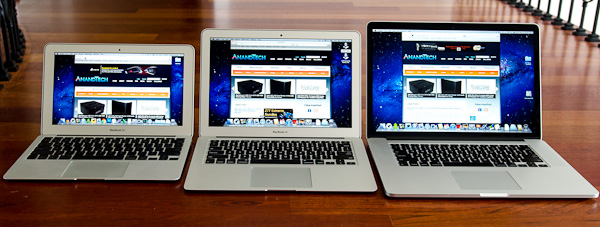
From left to right: 11-inch MacBook Air, 13-inch MacBook Air, MacBook Pro with Retina Display
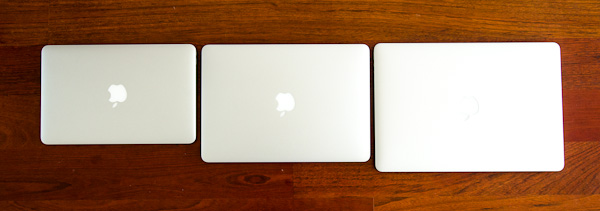
From left to right: 11-inch MacBook Air, 13-inch MacBook Air, MacBook Pro with Retina Display


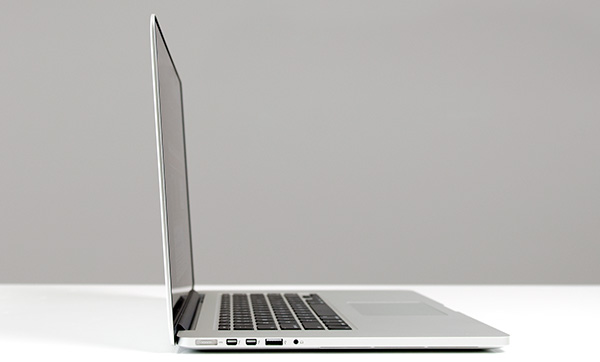
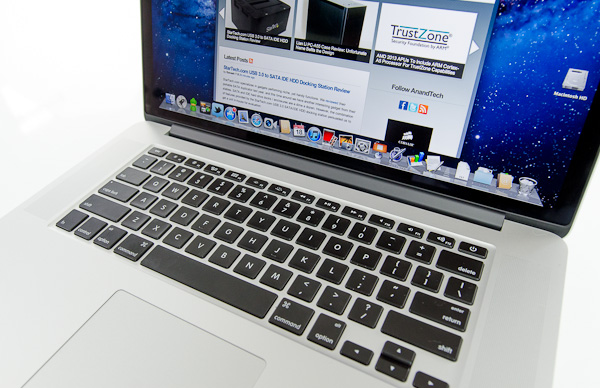
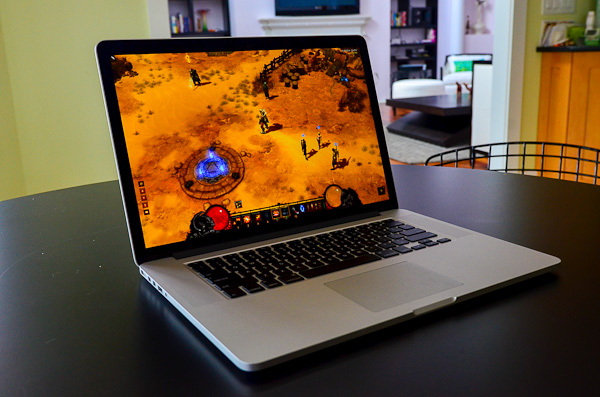
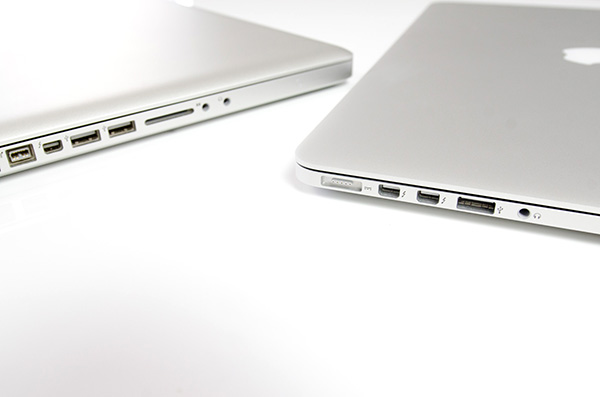
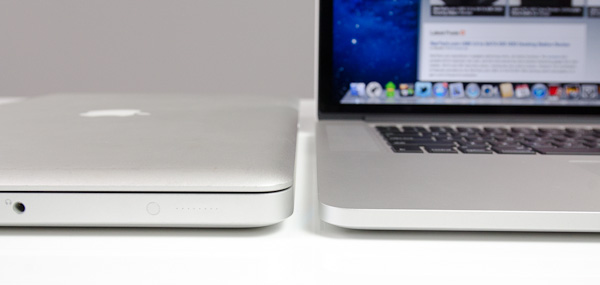








471 Comments
View All Comments
Fx1 - Monday, June 25, 2012 - link
It makes a big difference to the glare when you take away that glass. Why don't you go have a look at a rmbp and see how thin the lid is and you too will be impressed. A LOT of work must going into designing these notebooks. Why don't you spend you time bitching at the windows notebook makers and see how CRAP their designs are. Because they deserve it. Full Stop.Spunjji - Tuesday, June 26, 2012 - link
Why don't you go and eat a dick, child.gstrickler - Wednesday, June 27, 2012 - link
It's not a matte screen. Matte screens are etched to diffuse the light in many directions. This makes them slightly less "sharp", and lowers their effective brightness slightly. The Retina display in the new MBP has a low reflectance flat surface, not a matte surface. It's an important difference as an etched surface would compromise the sharpness of such a high DPI display.Spunjji - Monday, June 25, 2012 - link
I give up. Too many fanboys on both sides.jjbwbc - Monday, June 25, 2012 - link
I bought one of these guys and I really love the display but I cannot for my life see if this is glass or plastic or what makes the outer layer of this display.How fragile is it? I mean, it seems like a combination of durable and extremely fragile too. Makes me nervous... can anyone weigh in on how fragile the screen on this guy is compared to regular LCDs?
Constructor - Thursday, June 28, 2012 - link
It's definitely glass, and likely of the 'Gorilla' variety. It will still scratch or break if you try hard enough. But with no access to Apple's internal QA information we'll have to wait until someone actually manages to break theirs to really know...! ;-)SimaYi - Monday, June 25, 2012 - link
I'm disappointed in this review, as I was very much hoping to get some advice about whether this laptop can run recent games at 2880x1800.The only frame rates mentioned for this resolution were Half Life 2 (42 fps) and Diablo 3 (18 fps).
@Anand, is there any chance you will update this article with some detailed feedback about gaming at 2880x1800, and framerates for running recent Windows games in bootcamp at this res?
seapeople - Monday, June 25, 2012 - link
No, it can't run recent games at 2880x1800. This is not something that needs to be benchmarked; it is obvious from the combination of a middle-of-the-road laptop graphics card and the highest resolution notebook screen ever made.wfolta - Monday, June 25, 2012 - link
And you got this idea, despite the article mentioning Diablo III (about as recent of a game as you can get)? It runs Diablo III (Normal Act III) at 20+ FPS, with most settings cranked to max. It runs other recent games fine. Perhaps you should give details of what games you mean when you say "recent"?And the fact is you can run games at lower resolutions (which still look better at that resolution than if you only had that many pixels) and drop a few settings and double your frame rate.
SimaYi - Tuesday, June 26, 2012 - link
Thanks very much for the feedback!Are you saying from personal experience that it runs D3 on High at 20fps? How about if you reduce the settings, say with no AA and lower setttings, can it run D3 above 30fps?
For most games, 25-30 fps is quite playable. Above 30fps is great.
As for "recent" games, I would be extremely interested to know the performance at 2880x1800 (on low or med settings), for games like Skyrim, DXHR, RAGE, Arkham City, BF3, Sniper Elite V2, ME3, Risen 2, MW3, Witcher 2, Civ 5.
Never purchased a mac laptop before and this is the first time I'm seriously considering it, primarily because of the display. However, if I can't run any games at 2880x1800, it seems like a waste.
Trying to decide between either buying an MBP or a Windows laptop with 1080p display and decent GPU, along the lines of a DV6t (Nvidia 650m) or Envy 15 (AMD 7750m).
I wouldn't call the 650m necessarily "middle of the road," as it's one of the fastest mobile cards currently available for laptops that are not bulky desktop replacements. Do Mac laptops run games slower on bootcamp compared to Windows laptops with the same card?